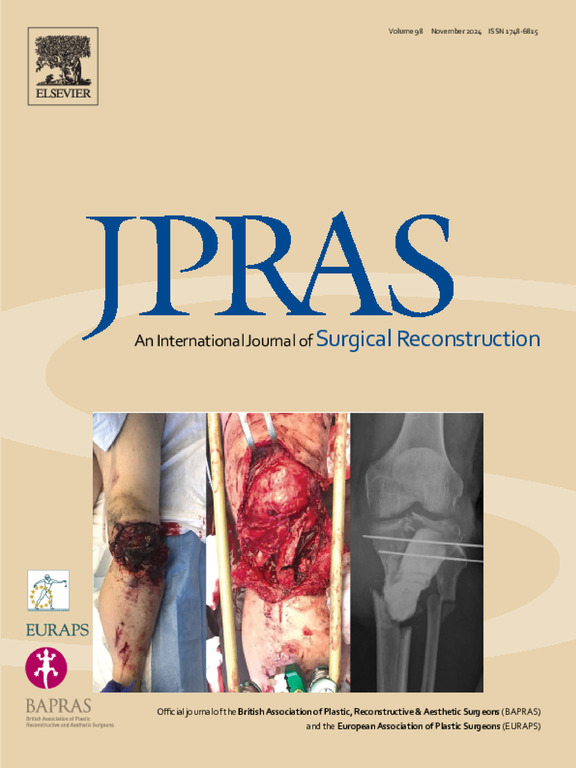财务毒性对下肢创伤患者的预后有负面影响
IF 2.4
3区 医学
Q2 SURGERY
Journal of Plastic Reconstructive and Aesthetic Surgery
Pub Date : 2025-07-03
DOI:10.1016/j.bjps.2025.06.025
引用次数: 0
摘要
经济毒性描述了伤害的不利经济影响,包括直接成本,如医疗费用,以及间接成本,如工资损失。财务毒性与较差的健康相关生活质量以及较差的心理和临床结果有关。我们的目的是在一个国际下肢创伤患者队列中描述金融毒性。方法对有股骨中部远端创伤性下肢损伤史的患者进行横断面调查。我们使用LIMB-Q收集了人口统计学、临床和患者报告的结果(PROs)数据。我们的主要结果是LIMB-Q财务负担评分(范围0-100,分数越低表明财务毒性越大)。结果共收集了301名调查对象的数据。平均年龄42岁(SD 16)。大多数受访者是男性(64%)、白人(65%)和美国人(71%),大学学历以下(56%),年收入低于3万美元(29%)。中位离伤时间为2年(IQR: 1-4)。大多数受访者只接受骨折固定(56%),其次是软组织重建(28%)和截肢(16%)。平均LIMB-Q财务负担评分为56分(SD 20)。截肢与最大的经济毒性相关(p < 0.05)。黑人种族、低教育水平和低收入与较大的金融毒性相关(p < 0.05)。更大的财务毒性与更差的肢体- q症状和心理量表得分相关(p<0.01)。财务毒性不随损伤时间的增加而变化(p>0.05)。结论下肢外伤患者发生经济毒性的危险因素包括截肢、软组织重建、黑人、低文化程度和低收入。经济毒性可能是改善高危患者临床结果的一个可改变的危险因素。本文章由计算机程序翻译,如有差异,请以英文原文为准。
Financial toxicity negatively impacts outcomes in lower extremity trauma patients
Background
Financial toxicity describes the adverse economic effects of injury, including both direct costs, such as the price of medical care, and indirect costs, such as lost wages. Financial toxicity is associated with worse health-related quality of life, as well as worse psychological and clinical outcomes. We aimed to characterize financial toxicity in an international cohort of lower extremity trauma patients.
Methods
We conducted a cross-sectional survey of patients with a history of traumatic lower extremity injury distal to the mid-femur. We collected demographic, clinical, and patient-reported outcomes (PROs) data using the LIMB-Q. Our primary outcome was the LIMB-Q Financial Burden score (range 0–100, lower scores indicate greater financial toxicity).
Results
We collected data from 301 respondents. Mean age was 42 years (SD 16). Most respondents were men (64%), White (65%), and American (71%) with less than a college degree (56%) and annual incomes of less than $30,000 (29%). The median time from injury was 2 years (IQR: 1–4). Most respondents underwent fracture fixation only (56%), followed by soft tissue reconstruction (28%), and amputation (16%). The mean LIMB-Q Financial Burden score was 56 (SD 20). Amputation was associated with the greatest financial toxicity (p<0.05). Black race, lower education level, and lower income were associated with greater financial toxicity (p<0.05). Greater financial toxicity was associated with worse scores on LIMB-Q Symptoms and Psychological scales (p<0.01). Financial toxicity did not change with increasing time from injury (p>0.05).
Conclusion
Risk factors for financial toxicity among lower extremity trauma patients included amputation, soft tissue reconstruction, Black race, lower education level, and lower income. Financial toxicity may be a modifiable risk factor for improving clinical outcomes in high-risk patients.
求助全文
通过发布文献求助,成功后即可免费获取论文全文。
去求助
来源期刊
CiteScore
3.10
自引率
11.10%
发文量
578
审稿时长
3.5 months
期刊介绍:
JPRAS An International Journal of Surgical Reconstruction is one of the world''s leading international journals, covering all the reconstructive and aesthetic aspects of plastic surgery.
The journal presents the latest surgical procedures with audit and outcome studies of new and established techniques in plastic surgery including: cleft lip and palate and other heads and neck surgery, hand surgery, lower limb trauma, burns, skin cancer, breast surgery and aesthetic surgery.

 求助内容:
求助内容: 应助结果提醒方式:
应助结果提醒方式:


